
Saturday, October 6, 2007
Read That Sign! round 3
The more Hindi I learn, the more I see in my photos from India (summer 2006). Here's a detail from a picture of a street in Agra. I'm proud to say I got this one right away. If you click on the photo, you'll be taken to the original, full photo, where I put the transliteration and some notes. You'll also see what was really the subject of the photo....


Tuesday, October 2, 2007
Pratap isn't the only one who writes postcards.
I got a postcard from my friend Aditya in Mumbai!
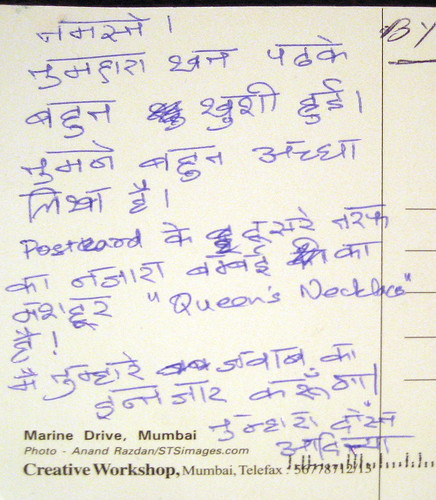
After 40 minutes, I had written out and looked up every word I could - and then had to turn to a friend for help reading and/or getting the meaning of the others. I need more patience - I get so frustrated when I can't read. But on the other hand, probably getting a taste of what iliteracy is like is a very useful thing.
The really cool part of this - other than getting a postcard from a foreign country, yay! - was that once someone told me what the words were, I could see how they knew. Once I knew what I was looking for, I could see it. Maybe that's dumb, but it feels like an improvement over _not_ being able to see it, at least. I did know quite a few words and was able to look up several more - v satisfying as well.
The transliteration is on the photo's Flickr page (with line breaks as they appear on the postcard), with much help from the glossary at the back of Snell and from Filmi Geek.
Oh! And the picture!


After 40 minutes, I had written out and looked up every word I could - and then had to turn to a friend for help reading and/or getting the meaning of the others. I need more patience - I get so frustrated when I can't read. But on the other hand, probably getting a taste of what iliteracy is like is a very useful thing.
The really cool part of this - other than getting a postcard from a foreign country, yay! - was that once someone told me what the words were, I could see how they knew. Once I knew what I was looking for, I could see it. Maybe that's dumb, but it feels like an improvement over _not_ being able to see it, at least. I did know quite a few words and was able to look up several more - v satisfying as well.
The transliteration is on the photo's Flickr page (with line breaks as they appear on the postcard), with much help from the glossary at the back of Snell and from Filmi Geek.
Oh! And the picture!

lyrics in Devanagari
I've run across Navin Kabra's Archive of Hindi Movie Songs site many times and never explored it. But today I finally poked around and discovered that the site has a ton of songs written out in Devanagari - and indexed in seven ways (including type of song - qawwalis, birthday, rain, etc.), which makes my inner library really happy. In honor of my recently watching Teesri Manzil, maybe I'll try to read O Haseenaa Zulfonwaalee during my lunch hour.
Saturday, September 22, 2007
Read That Sign! round 2
After reading Ultrabrown's post on the Wagah Border and its delightful/baffling display of patriotism, I flipped through some pictures from my trip there in July 2006. Here's a sign that faces you as you enter the Indian side of the arena (that might not be quite the right term, but it's stepped seats full of cheering crowds, so it seems to fit).

I feel like I should be able to identify these words, but I can't quite do it. My guess is:
svarn jayantee dvaar
With the help of Word AnyWhere, maybe this is
gold ____ gate. Now if only I could figure out the _____.

I feel like I should be able to identify these words, but I can't quite do it. My guess is:
svarn jayantee dvaar
With the help of Word AnyWhere, maybe this is
gold ____ gate. Now if only I could figure out the _____.
Sunday, September 9, 2007
typing in Devanagari
I found a post on the ePandit Hindi blog yesterday that appears to be a review of various systems for typing in Devanagari. I can't remotely read the post, and if someone would like to summarize it for me, I'd be grateful. But links know no linguistic bounds, so I was able to find Bahara, (which Filmi Geek had already told me about), HindiWriter, and Bhasha. I haven't had time to play with any of these, and I will be gob-smacked if any of them work on a Mac (and then I'll dance a merry jig).
I also thought I should let you know why I haven't been getting much Hindi done over the summer. My regular tutor was gone for the summer, studying in Jaipur, but I lined up a really good substitute. Or so I thought.

He may be a native speaker, but it turns out that he was really keen to use his English while in the US. He was also still feeling a little shy, and he was convinced that if he spoke in Hindi his low profile would be blown and throngs of screaming girls would ruin his vacation. And whenever I tried to crack the book, he insisted on turning it to this particular page, even though I'm only in chapter three....
I also thought I should let you know why I haven't been getting much Hindi done over the summer. My regular tutor was gone for the summer, studying in Jaipur, but I lined up a really good substitute. Or so I thought.

He may be a native speaker, but it turns out that he was really keen to use his English while in the US. He was also still feeling a little shy, and he was convinced that if he spoke in Hindi his low profile would be blown and throngs of screaming girls would ruin his vacation. And whenever I tried to crack the book, he insisted on turning it to this particular page, even though I'm only in chapter three....
Saturday, September 8, 2007
Think writing your date's name in Devanagari is a show-stopper? Think twice.
This tale from Hindi student Katherine Russel Rich admittedly has little to do with learning Hindi but packs a wallop in just two pages. And it mentions her forthcoming book about her experiences spending a year in India studying, titled Unspeakable: A Story About India and Life in Other Words. Looks great.
Thanks to friend, journalist, and international woman of mystery and beauty Anubha for the story.
Thanks to friend, journalist, and international woman of mystery and beauty Anubha for the story.
Sunday, August 5, 2007
(D)evanagari U(nder the) I(nfluence)
I'd been craving a beer at my favorite bar for days, so when a friend said she'd be up for some french fries and a shirley temple before studying at the coffee shop, I couldn't resist. News flash: total lightweights should not have a drink before trying new vocabulary and writing in a not-entirely-learned script. The effects were even more wobbly than usual. After writing out all the masculine nouns, I browsed the chapter and realized cases were coming. And closed the book. Cases did me in in Latin back in my sophomore year of college, and while I am not going to let them win this time, today was definitely not the day to prove it.
Hic.
Hic.
Wednesday, July 25, 2007
Oh, those pesky pronouns
Namaste, slackers! Normally I would hang my head in shame and join your ranks (I am very much of the "What do we want? Procrastination! When do we want it? Later!" school of thought), but believe it or not, this summer I took my Hindi learning kit with me on my vacation and actually did some work. No one was more surprised than me, I can tell you that much. My enthusiasm waned somewhat when I got to oblique and direct cases, but still, I'm about halfway through Unit 3 now and able to tell you that मेरी किताबें मेज़ पर हैं and that मैं घर में हूँ and surely that is all that matters.
I do have a question, though. I understand about aap-tum-tu and the differences between them, but while my book tells me that main is I and hum is we, I've also seen hum used to mean I (eg. in Hum Tum), so ... what's up with that? Is hum-main kind of like aap-tum? Can anyone explain? बहुत शुक्रिया!
I do have a question, though. I understand about aap-tum-tu and the differences between them, but while my book tells me that main is I and hum is we, I've also seen hum used to mean I (eg. in Hum Tum), so ... what's up with that? Is hum-main kind of like aap-tum? Can anyone explain? बहुत शुक्रिया!
Monday, July 9, 2007
Monday, May 21, 2007
Did you forget to feed the cat again?
So the book's been teaching me about invariable adjectives and adjectives with masculine/feminine endings, and ... Well, check out this sentence demonstrating an invariable adjective:
क्या बिल्ली जिन्दा है?
Yes, that means "Is the cat alive?" I'm not sure whether I should be amused or worried ... In any case, it's brought back memories of my high school German teacher, who taught us prepositions by using examples like, "The fork is on the roof. Is your sister under the chair? Who put the dog in the attic? My shoes are not in the bathtub."
Also, I can now count up to 20! I learnt to count up to 5 from the movies, then up to 13 from KBC, so I'm good with those, but I do need to practice 14 to 20 some more.
Next up: tu vs. tum vs. aap, and then Unit 3!
क्या बिल्ली जिन्दा है?
Yes, that means "Is the cat alive?" I'm not sure whether I should be amused or worried ... In any case, it's brought back memories of my high school German teacher, who taught us prepositions by using examples like, "The fork is on the roof. Is your sister under the chair? Who put the dog in the attic? My shoes are not in the bathtub."
Also, I can now count up to 20! I learnt to count up to 5 from the movies, then up to 13 from KBC, so I'm good with those, but I do need to practice 14 to 20 some more.
Next up: tu vs. tum vs. aap, and then Unit 3!
Thursday, May 10, 2007
Eat my dust, Unit 1!
Yesss! I just finished the last exercise in Unit 1 - answering questions like वह हिन्दुस्तानी है? वह शादी-शुदा है? वह सुखी है? वह अमरीकन है? * about the three people introduced at the beginning of the exercise. Nothing particularly fascinating to report there, except that two of the people were called Suresh Khanna and Vinod Kumar, which I kept unintentionally combining into Vinod Khanna ...
There were so many new words in Unit 1 that I decided to keep my own glossary (but really I just wanted an excuse to use my glitter pens).

Next up: Unit 2 with numbers, genders and levels of formality! Then I might finally be able to come up with my own sentences, rather than just translating the ones in the book. I see some exciting times ahead!
* Is (s)he Indian? Is (s)he married? Is (s)he happy? Is (s)he American?
There were so many new words in Unit 1 that I decided to keep my own glossary (but really I just wanted an excuse to use my glitter pens).

Next up: Unit 2 with numbers, genders and levels of formality! Then I might finally be able to come up with my own sentences, rather than just translating the ones in the book. I see some exciting times ahead!
* Is (s)he Indian? Is (s)he married? Is (s)he happy? Is (s)he American?
Wednesday, May 9, 2007
वह खूबसूरत आदमी कौन था?*
This is not only a very good question to know (very practical when you are out stalking Bollywood's खूबसूरत आदमी ** in the dark) but also the title of chapter 4, which is the last chapter I remember from the Hindi class I took a while ago. For a while now I haven't been a good girl and wasn't studying Hindi very diligently but now seems like a good time to start again.
So, in the time honoured tradition, I present my high-tech equipment:
A few books ...
A stack of index cards with lots of grammar most of which I don't actually remember ...
And a fabulous pad with coloured paper, some of my writing - and lots of grammar that I actually sort of remember ...
And of course I need my trusty iPod to listen to the Learn Hindi from Bollywood Movies Podcast which has taught me lots of useful phrases to use when the खूबसूरत आदमी I'm stalking turns out to be Johnny Lever ...
By the way -the ़खूबसूरत आदमी in chapter 4 is called Suhas and Sangeeta would like you to know one thing: vah sirf mera dost hai!
*Vah khubsurat aadmi kaun tha? - Who is this handsome man?
**Is that the proper plural? खूबसूरत is an invariable adjective, isn't it?
A big thank you to Carla for the spelling advice!
So, in the time honoured tradition, I present my high-tech equipment:
A few books ...
A stack of index cards with lots of grammar most of which I don't actually remember ...
And a fabulous pad with coloured paper, some of my writing - and lots of grammar that I actually sort of remember ...
And of course I need my trusty iPod to listen to the Learn Hindi from Bollywood Movies Podcast which has taught me lots of useful phrases to use when the खूबसूरत आदमी I'm stalking turns out to be Johnny Lever ...
By the way -the ़खूबसूरत आदमी in chapter 4 is called Suhas and Sangeeta would like you to know one thing: vah sirf mera dost hai!
*Vah khubsurat aadmi kaun tha? - Who is this handsome man?
**Is that the proper plural? खूबसूरत is an invariable adjective, isn't it?
A big thank you to Carla for the spelling advice!
Tuesday, May 8, 2007
sign, sign everywhere a sign
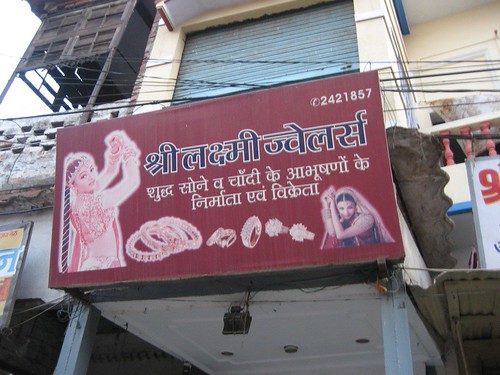
I've started going through some of my photos from my trip to India last summer, trying to work through the Devanagari, and Trivial Matters helped me with this one. That was a real labor of love on his part, too; it took me at least half an hour, with TM saying "Now what do you think could come after LA?". It's amazing to me how thrown I am by fonts that are different from those in my book. If you want to reenact the painful process, click on the photo to go to the flickr page, where I put the answers and some notes on the bits I found hardest.
Sunday, April 29, 2007
"Pratap's little problem"*
I'm already in chapter two and have failed to write about what our friend Pratap** was up to in chapter one! As if learning the vocabulary isn't hard enough. Phew! Okay, so, in chapter one, Pratap arrives in Delhi and meets his host Kamala and a boy named Raj (who I assume is Kamala's son, but I'm not sure; otherwise this adult-looking woman is randomly hanging out with children). Kamla, Raj, and Pratap determine that everyone is okay, thank you, and that Pratap is not in fact English but Indian (the dialogue title is "Pratap from London meets his Delhi host" - is Pratap an NRI? studying abroad? we'll never know) and that Marutis cars are not Japanese (I already knew that). Kamala then shows him his room, which has two cupboards, two chairs, a table, and a window. But no fan. No fan. Poor Pratap! पंखा, according to my tutor, is the most important word in Hindi. Pratap wrote about his adventures in his journal, which was pleasingly not too difficult to translate and mentions a beautiful garden.
In chapter two, Pratap meets his Hindi teacher, Sharma ji. He finds out that Teach Yourself Hindi is not a bad book and that the Ramayana is a very thick book (good to know in case the oft-used descriptor "epic" had you confused about that - then again, I feel pretty confused [and thick] myself whenever I work on these exercises, so I shouldn't be snarky). As for the title of this post, it seems our friend Pratap has gotten himself into a bit of a pickle. Turns out Sangeeta is upset because...well, because Pratap is around. That's all we know. Raj seems to think that perhaps her anger is due to her being a girl. Thanks, Dr. Snell, for teaching us how to express sexism so early in our fledgling exploration of Hindi. In contrast to the drama of the dialogue, Pratap's postcard home is pretty dull. He thinks the weather in Delhi is nice (not my experience of Delhi, but of course he's there in January and I was there in July - and what kind of moron goes to Delhi in July?) but that the city is polluted. Not as bad as Bangalore, says I, but I do not know where else in India Pratap has been or where he is from.
* I promise this is the actual title of the dialogue. I wouldn't make that up.
** Most of the time I am not going to bother to put in accent marks and things that would make this proper transliteration. Life is way too short.
In chapter two, Pratap meets his Hindi teacher, Sharma ji. He finds out that Teach Yourself Hindi is not a bad book and that the Ramayana is a very thick book (good to know in case the oft-used descriptor "epic" had you confused about that - then again, I feel pretty confused [and thick] myself whenever I work on these exercises, so I shouldn't be snarky). As for the title of this post, it seems our friend Pratap has gotten himself into a bit of a pickle. Turns out Sangeeta is upset because...well, because Pratap is around. That's all we know. Raj seems to think that perhaps her anger is due to her being a girl. Thanks, Dr. Snell, for teaching us how to express sexism so early in our fledgling exploration of Hindi. In contrast to the drama of the dialogue, Pratap's postcard home is pretty dull. He thinks the weather in Delhi is nice (not my experience of Delhi, but of course he's there in January and I was there in July - and what kind of moron goes to Delhi in July?) but that the city is polluted. Not as bad as Bangalore, says I, but I do not know where else in India Pratap has been or where he is from.
* I promise this is the actual title of the dialogue. I wouldn't make that up.
** Most of the time I am not going to bother to put in accent marks and things that would make this proper transliteration. Life is way too short.
Tuesday, April 24, 2007
Blogger and Devanagari
Maja, via the Buddha Smiled, I believe, told me how to get Blogger to transliterate into Devanagari:
Let me tell you this, though (Michael und Babasko, hören sie?): good luck on a Mac. The Blogger transliteration function doesn't work on Safari, and Firefox can't handle Devanagari. My solution is going to be to use ITRANS to transliterate, then cut and paste. Geebus.
And I have to say, as much as I would like "snells" to connote little fuzzy creatures, to me the word sounds like a medical condition. "Ohhhh, I'd love to come over and watch a Shashi movie, but I'm really tired. I think I'm coming down with the snells."
Update to post (an hour after I wrote it): holy Indic scripts, Batman! It appears that, at least on the version of Firefox I'm running right this minute, 1.5.0.4, you can use Devanagari with Firefox on Macs! I cannot express how happy this makes me. I hope to get to the bottom of this later this week, but in the meantime, शाबाश!
ooh well it's easy! From your Blogger Dashboard, go to Settings, scroll down a bit on the Basic Settings page and it's there under the Global Settings heading. It says "Show transliteration button for your posts?" so change that to Yes, and then when you're writing a new post, you have to be in the Compose mode, not Edit, and you'll see a button with the Hindi A on it. If you turn it on right away, it'll convert each word into Devanagari as soon as you finish writing it and press Space, or you can write the whole text, then highlight it and click the button. It's genius, there's a short post about it here http://googleblog.blogspot.com/2007/04/now-you-can-blog-in-hindi.html
and here's the Blogger help thingy for it http://help.blogger.com/bin/answer.py?answer=58226
Let me tell you this, though (Michael und Babasko, hören sie?): good luck on a Mac. The Blogger transliteration function doesn't work on Safari, and Firefox can't handle Devanagari. My solution is going to be to use ITRANS to transliterate, then cut and paste. Geebus.
And I have to say, as much as I would like "snells" to connote little fuzzy creatures, to me the word sounds like a medical condition. "Ohhhh, I'd love to come over and watch a Shashi movie, but I'm really tired. I think I'm coming down with the snells."
Update to post (an hour after I wrote it): holy Indic scripts, Batman! It appears that, at least on the version of Firefox I'm running right this minute, 1.5.0.4, you can use Devanagari with Firefox on Macs! I cannot express how happy this makes me. I hope to get to the bottom of this later this week, but in the meantime, शाबाश!
Main Pratap nahin hoon
I might not have flashcards or a special bag, but what I do have among my Hindi-learning equipment is a very pretty business card (with butterflies!) from Ganesha that I'm using as a bookmark, and also a number of glitter pens.
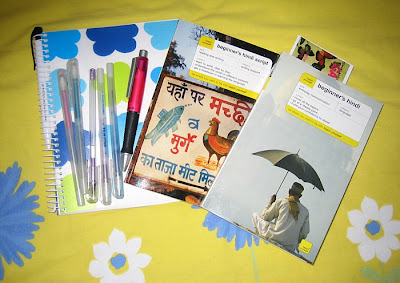
It also turns out that I have a slightly different grammar textbook than Beth, and unfortunately mine doesn't feature Pratap. The main characters in my book are Raju, a teacher, his wife Gita, who is a doctor, and their three children Manoj, Meena and Ram. They also have a dog ("Moti (male, age unknown)") and they all live in Agra. I've skimmed through the book a bit and it turns out in one of the dialogues that Gita has a bit of a thing for Shahrukh Khan, so even though I don't know much about her, other than that वह हिन्दुस्तानी है (she is Indian) and वह डाक्टर है (she is a doctor), I like her already!
I got these books back in February this year. What I've done so far is learn the script, although I tend to forget most of the conjuncts and I still have to learn how to write numbers. After learning the script, I started with the grammar book and I'm in the middle of chapter 1 at the moment. Here are the very first exercise and the one I did last:


This is a conversation between Manoj and his inquisitive neighbour Javed:
Javed: What is this?
Manoj: This is my radio.
Javed: Who is that boy?
Manoj: He is my brother.
Javed: What is his name?
Manoj: His name is Ram.
Javed: Who is that girl?
Manoj: Her name is Meena.
Javed: Is she ill?
Manoj: No, she is not ill. She is OK.

It also turns out that I have a slightly different grammar textbook than Beth, and unfortunately mine doesn't feature Pratap. The main characters in my book are Raju, a teacher, his wife Gita, who is a doctor, and their three children Manoj, Meena and Ram. They also have a dog ("Moti (male, age unknown)") and they all live in Agra. I've skimmed through the book a bit and it turns out in one of the dialogues that Gita has a bit of a thing for Shahrukh Khan, so even though I don't know much about her, other than that वह हिन्दुस्तानी है (she is Indian) and वह डाक्टर है (she is a doctor), I like her already!
I got these books back in February this year. What I've done so far is learn the script, although I tend to forget most of the conjuncts and I still have to learn how to write numbers. After learning the script, I started with the grammar book and I'm in the middle of chapter 1 at the moment. Here are the very first exercise and the one I did last:


This is a conversation between Manoj and his inquisitive neighbour Javed:
Javed: What is this?
Manoj: This is my radio.
Javed: Who is that boy?
Manoj: He is my brother.
Javed: What is his name?
Manoj: His name is Ram.
Javed: Who is that girl?
Manoj: Her name is Meena.
Javed: Is she ill?
Manoj: No, she is not ill. She is OK.
Saturday, April 21, 2007
amongst our weaponry are...
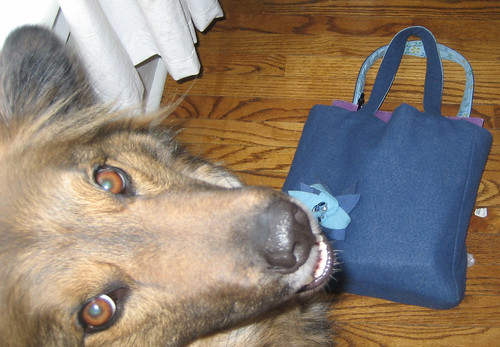
My Hindi-learning companion (Leroy) and the bag in which I tote around all my Hindi-learning stuff, which is as follows:
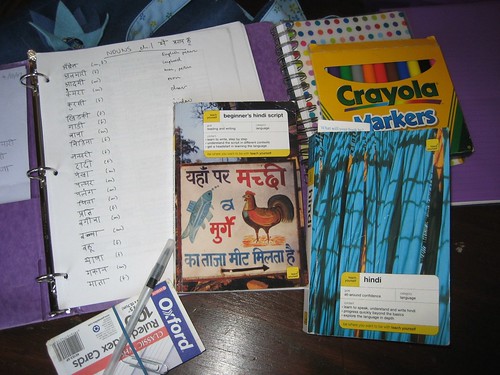
Snell x 2, paper, index cards, a pen, and markers. I am ready.
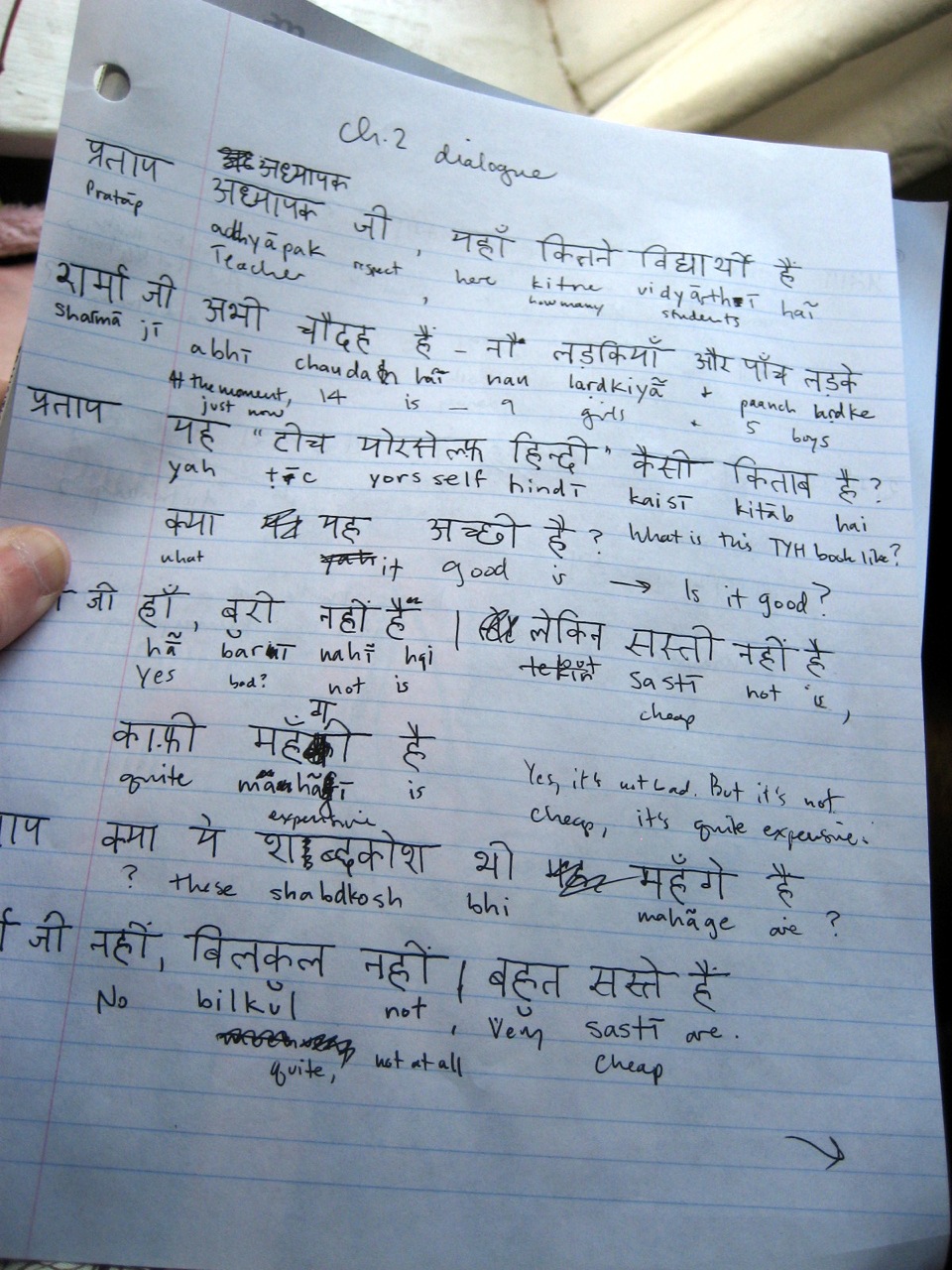
My first attempt at writing out the first dialogue in chapter 2. Our friend Pratap is talking about Hindi books with a teacher. My favorite part of this is on the back of the page. Pratap asks if a certain thick book is a dictionary, and the teacher, Sharmaji, says "No, it's the Ramayana." That's decidedly a step up in interestingness from the contents of Pratap's room at Kamala's house (fan, bed, chairs, etc.).
Wednesday, April 18, 2007
a most inauspicious beginning
I was going to write out the famous "Main Pratap hoon" dialogue for everyone, but I see the fine print says that the Hindi transliteration function is not supported for Macs, so there goes that idea. Bugger. I guess I'll do it by hand and scan it in. It is a crazy, mixed-up world when I find myself wishing for access to a PC.
Subscribe to:
Comments (Atom)



